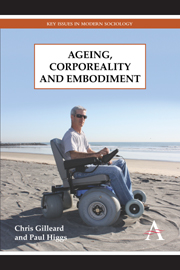Book contents
- Frontmatter
- Contents
- Introduction
- Chapter 1 Identity, Embodiment and the Somatic Turn in the Social Sciences
- Chapter 2 Corporeality, Embodiment and the ‘New Ageing’
- Chapter 3 Gender, Ageing and Embodiment
- Chapter 4 Age and the Racialised Body
- Chapter 5 Disability, Ageing and Identity
- Chapter 6 Sexuality, Ageing and Identity
- Chapter 7 Sex and Ageing
- Chapter 8 Cosmetics, Clothing and Fashionable Ageing
- Chapter 9 Fitness, Exercise and the Ageing Body
- Chapter 10 Ageing and Aspirational Medicine
- Conclusions: Ageing, Forever Embodied
- References
- Index
- ADVANCE PRAISE
Conclusions: Ageing, Forever Embodied
Published online by Cambridge University Press: 05 July 2013
- Frontmatter
- Contents
- Introduction
- Chapter 1 Identity, Embodiment and the Somatic Turn in the Social Sciences
- Chapter 2 Corporeality, Embodiment and the ‘New Ageing’
- Chapter 3 Gender, Ageing and Embodiment
- Chapter 4 Age and the Racialised Body
- Chapter 5 Disability, Ageing and Identity
- Chapter 6 Sexuality, Ageing and Identity
- Chapter 7 Sex and Ageing
- Chapter 8 Cosmetics, Clothing and Fashionable Ageing
- Chapter 9 Fitness, Exercise and the Ageing Body
- Chapter 10 Ageing and Aspirational Medicine
- Conclusions: Ageing, Forever Embodied
- References
- Index
- ADVANCE PRAISE
Summary
Our aim in writing this book has been to pursue a debate about the place of the body in ageing studies and, more broadly, in the social sciences. Central to this debate has been the contested framework by which the body is seen to mediate the relationship between the individual and society. While each individual is, or owns, his or her body, the meaning of that body and the meaning that confers on the self who owns the body is realised only and necessarily within social relations. This is the case, whether in the way that individual bodies are used to represent social identities, in the way that they express cultural distinctions, perform social functions or reproduce social positions and in the way that bodies are realised as distinct kinds of individuals, within the medium of our social imaginaries. In order to distinguish between two different ways of understanding the body and the body's relation to society, we have deployed the contrasting concepts of corporeality and embodiment. The corporeality of the body - its fleshy materiality and capacity to grow, generate and decay - serves as a contrast to the more thoroughly socialised concept of embodiment. It represents a materiality which, even if reproduced socially can never be socially produced. It starts each human being off as a human being whose history is located not so much in society as in its species being.
- Type
- Chapter
- Information
- Ageing, Corporeality and Embodiment , pp. 159 - 166Publisher: Anthem PressPrint publication year: 2013



